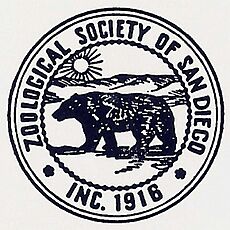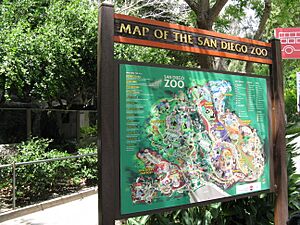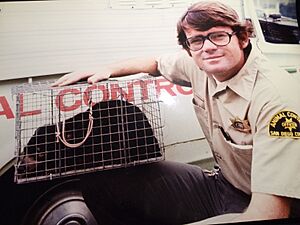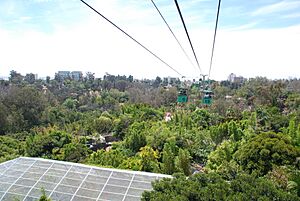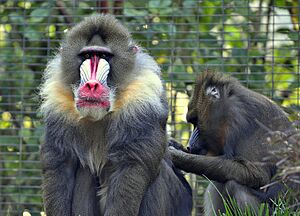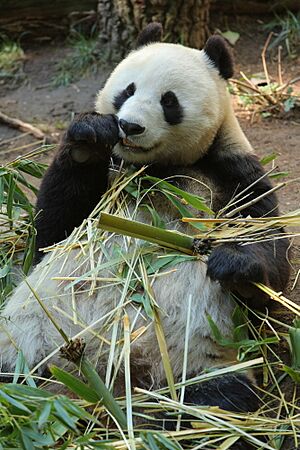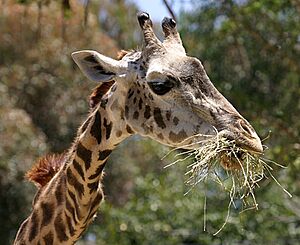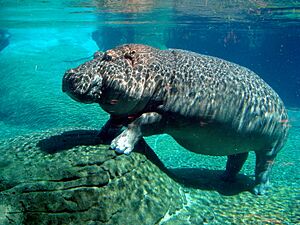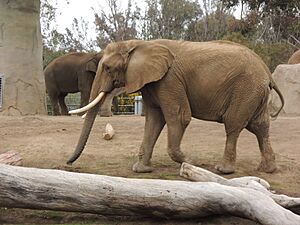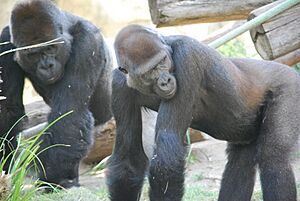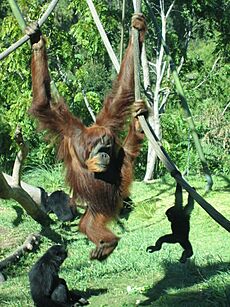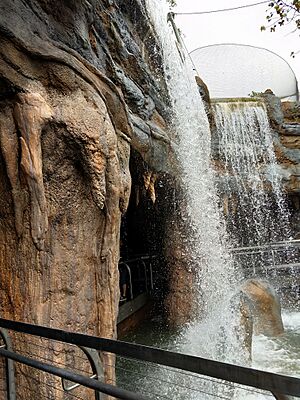San Diego Zoo facts for kids
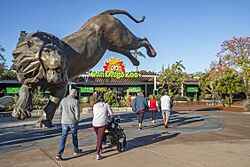
Entrance to the zoo with sculpture Rex's Roar, after the lion that inspired the zoo
|
|
| Date opened | 1916 (Precursor Panama–California Exposition in previous year) |
|---|---|
| Location | Balboa Park, San Diego, California, U.S. |
| Land area | 99 acres (40 ha) |
| Coordinates | 32°44′10″N 117°09′05″W / 32.73611°N 117.15139°W |
| No. of animals | 3,700+ |
| No. of species | 650+ (incl. subspecies) |
| Annual visitors | 4 million (2018) |
| Memberships | AZA, AAM, WAZA |
| Major exhibits | Absolutely Apes, Wildlife Explorers Basecamp, Elephant Odyssey, Panda Ridge, Lost Forest, Monkey Trails, Polar Bear Plunge, Africa Rocks |
The San Diego Zoo is a world-famous zoo located in Balboa Park in San Diego, California. It was started by Dr. Harry M. Wegeforth with a group of animals left over from the 1915 Panama–California Exposition. The zoo was one of the first to create open-air, cageless exhibits that look like the animals' natural homes.
Covering 100 acres, the zoo is home to over 12,000 animals from more than 680 species. It is the most visited zoo in the United States and is often called one of the best zoos in the world.
The zoo is run by the San Diego Zoo Wildlife Alliance, a non-profit group dedicated to saving wildlife. This group also runs the San Diego Zoo Safari Park.
History of the Zoo
The San Diego Zoo began after the 1915 Panama–California Exposition left behind a collection of exotic animals. Dr. Harry M. Wegeforth founded the Zoological Society of San Diego on October 2, 1916, to care for them. He was inspired after hearing a lion roar at the exposition.
"Wouldn't it be wonderful to have a zoo in San Diego? I believe I'll build one."
In 1921, the city set aside land in Balboa Park for the zoo. The city agreed to own the animals, while the zoo would manage them. A fence was built with funding from Ellen Browning Scripps, allowing the zoo to charge an entrance fee to help pay for costs.
Belle Benchley became the zoo director in 1925 and held the position until 1953. For most of her time as director, she was the only woman in the world to hold such a job.
The San Diego Zoo was a leader in creating "cageless" exhibits. Dr. Wegeforth wanted to use moats instead of bars to keep animals in their habitats. The first moated lion exhibit opened in 1922.
Saving Endangered Animals
In 1975, the zoo founded the Center for Reproduction of Endangered Species (CRES). This center, now called the Institute for Conservation Research, works to save animals from extinction.
The zoo is famous for its koalas and has the largest number of them outside of Australia. In 1997, the world's only known albino koala in a zoo was born here. His name was Onya-Birri, which means "ghost boy" in an Australian Aboriginal language.
In 2014, a colony of African penguins arrived at the zoo for the first time since 1979. They now live in the Africa Rocks exhibit.
Famous Animal Escapes
The zoo has had a few famous animal escape artists. The most well-known was Ken Allen, a Bornean orangutan nicknamed "the hairy Houdini" for his many escapes.
In 2015, two Wolf's guenon monkeys got out of their enclosure but were safely returned. In 2023, a female red panda named Adira escaped for a few hours but was found nearby and led back home.
Getting Around the Zoo
The zoo is large, but there are easy ways to see it all. A guided tour bus takes you through about 75% of the park.
You can also ride the Skyfari, an overhead gondola lift that gives you an amazing aerial view of the zoo and Balboa Park.
The zoo is also a botanical garden, with more than 700,000 exotic plants. It even grows special food for the animals, like 40 types of bamboo and 18 kinds of eucalyptus trees for the koalas.
Exhibits
Monkey Trails and Forest Tales
Monkey Trails is home to monkeys and other animals from the rainforests of Asia and Africa. You can see Angola colobus monkeys, tufted capuchins, and colorful mandrills.
This area also has a pair of pygmy hippopotamuses. They share their underwater-viewing pond with many African fish. The exhibit has two levels, so you can watch the tree-dwelling animals from both the ground and the treetops.
Aviaries: Homes for Birds
The zoo has some of the largest free-flight aviaries in the world, where birds can fly freely in large, enclosed spaces.
- Owens Aviary is home to about 200 tropical birds from places like Australasia and Papua New Guinea. A waterfall and lush plants make it feel like a real jungle.
- Scripps Aviary houses colorful birds from Africa, such as the violet-backed starling and the great blue turaco.
- Parker Aviary features birds from South America, including Andean cock-of-the-rocks and keel-billed toucans.
Asian Passage
For many years, the San Diego Zoo was famous for its giant pandas. It was one of only four zoos in the U.S. to have them and was very successful at breeding them. The first two panda cubs to be born and survive in the U.S., Hua Mei and Mei Sheng, were born here.
In 2019, the panda loan agreement with China ended, and the pandas returned home. However, in June 2024, two new pandas, Yun Chuan and Xin Bao, arrived at the zoo. They made their public debut on August 8, 2024. The area also features other Asian animals like snow leopards and red pandas.
Urban Jungle
The Urban Jungle is home to a herd of Masai giraffes, American flamingoes, and a male Indian rhinoceros.
Many of the zoo's "animal ambassadors" live here. These are animals that help teach visitors about wildlife, including a binturong, red kangaroos, and South African cheetahs.
Polar Bear Plunge
This exhibit is designed to look like the Arctic. It is home to three polar bears named Kalluk, Chinook, and Tatqiq. You can watch them swim in their 130,000-gallon pool from an underwater viewing area.
The area also features other arctic animals like reindeer and arctic foxes. Nearby, you can see mountain lions, maned wolves, and several types of eagles.
Wildlife Explorers Basecamp
Opened in 2022, this area replaced the old Children's Zoo. It's designed for kids to get up close with animals and learn through play. It has four zones based on different ecosystems: Desert Dunes, Wild Woods, Marsh Meadows, and Rainforest.
You can see sloths, ocelots, fennec foxes, and squirrel monkeys. The Spineless Marvels building features insects and other invertebrates, while Cool Critters houses fish, reptiles, and amphibians.
Lost Forest
This exhibit is modeled after the Ituri Forest in central Africa. It features animals like the shy okapi, forest buffalo, and playful spotted-necked otters.
The main attraction is the hippopotamus exhibit, which has an underwater viewing area. Here you can watch the giant hippos swim gracefully.
Elephant Odyssey
This 2.5-acre exhibit is home to the zoo's herd of elephants. It also takes you on a journey into the past. You can see life-size statues of ancient animals that once lived in Southern California, like the Columbian mammoth and the saber-toothed cat.
Modern-day animals in this area include jaguars, African lions, Baird's tapirs, and California condors. There is also an Elephant Care Center where you can watch keepers look after these gentle giants.
Gorilla Tropics
Opened in 1991, this exhibit simulates the rainforests of central Africa. It is home to a family of six western lowland gorillas. You can watch them play in a large, grassy meadow with waterfalls and tropical plants.
Nearby, you can also see bonobos, which are close relatives of chimpanzees, and several aviaries with beautiful birds.
Absolutely Apes
This exhibit is home to Sumatran orangutans and siamangs. The large, open-air habitat has sway poles and artificial trees for the apes to climb and swing on.
A 110-foot-long glass window gives visitors a clear view of these intelligent animals. The viewing area is designed to be fun for kids, with rubber mulch and small sway poles to play on.
Africa Rocks
This large exhibit highlights the amazing variety of life in Africa. It is divided into six different habitats.
- Cape Fynbos features a colony of African penguins in a habitat that looks like Boulders Beach in South Africa. They share their huge pool with leopard sharks.
- Acacia Woodland is home to leopards and vervet monkeys.
- Madagascar Forest showcases several species of lemur and their main predator, the fossa.
- Ethiopian Highlands houses unique primates like the gelada and the hamadryas baboon.
- Kopje is a rocky outcrop where you can see klipspringers and meerkats.
- West African Forest has West African dwarf crocodiles and a stunning 65-foot waterfall.
Conservation Efforts
The San Diego Zoo is a leader in conservation. Its Institute for Conservation Research works to save endangered species around the world. The zoo has breeding programs for animals like the California condor, black rhino, and tiger.
Thanks to these efforts, the zoo has helped reintroduce over 30 endangered species back into the wild. Their "frozen zoo" stores rare sperm and eggs, which can be used to help save species from extinction in the future.
See also
 In Spanish: Zoológico de San Diego para niños
In Spanish: Zoológico de San Diego para niños
- Panda diplomacy – The practice of using pandas as diplomatic tools
- Balboa Park – The park where the San Diego Zoo is located
- San Diego Zoo Global – The organization overseeing the zoo and its conservation efforts
- San Diego Zoo Safari Park – A sister facility of the San Diego Zoo
- Nola (rhinoceros) – A northern white rhinoceros that lived at the zoo
- Bai Yun – A giant panda formerly housed at the San Diego Zoo
- Gao Gao – A giant panda, part of the zoo's breeding program
- Hua Mei – The first giant panda cub born in the United States
- Mei Sheng – A male giant panda born at the zoo
- Shi Shi (giant panda) – A giant panda lent to the zoo as part of a conservation exchange
- Su Lin (giant panda, born 2005) – A female panda born at the zoo
- Zhen Zhen – A female panda born at the zoo
- Xiao Liwu – The youngest panda born at the zoo before the panda program ended
- Ken Allen – A famous orangutan known for his escape artistry
- Karen (orangutan) – An orangutan famous for undergoing open-heart surgery
- Karta (orangutan) – An orangutan from the Adelaide Zoo, mother of celebrity orangutan Karen (orangutan)
- Belle Benchley – Former director of the San Diego Zoo, known as "The Zoo Lady"


